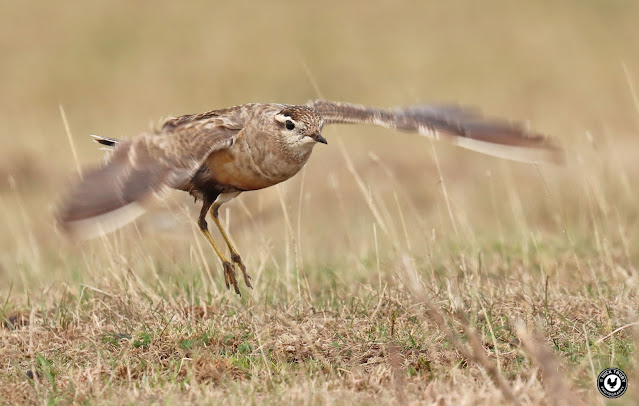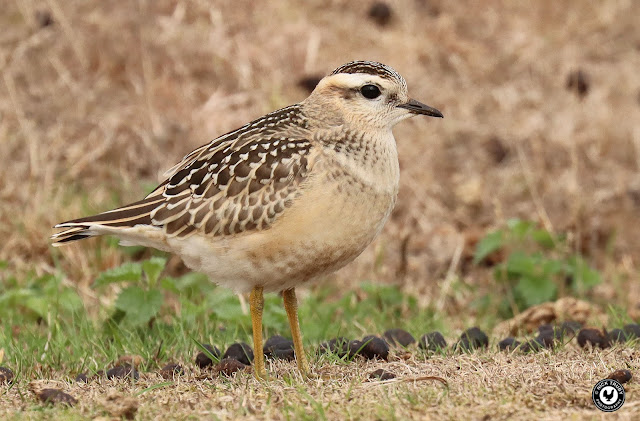I was at work after an eventful and birding packed weekend when Mrs Caley and myself had finally seen a Wryneck, and a Grey Plover, this year but had failed to add a Kentish Plover to our year list. At around 11:25 my phone sprang into life announcing an incoming message on our local WhatsApp group stating quite simply; 'Standby, Common Nighthawk in Wantage, details to follow'. What? A Nighthawk in Oxon? I'd have fallen over if it wasn't for the fact that I shuffle around on my knees for a living!
Fifteen minutes later the details arrived in the same matter of factly way, ' Common Nighthawk on a garden fence, access arranged' and a historic twitch was on. I now had a choice to make. Did I play it cool and carry on working and go to see the bird later in the day or leave immediately? A BirdGuides alert regarding the Nighthawk a few minutes later made that decision easy. I dropped everything, hurriedly tidied tools up and left for home after texting Mrs Caley and telling her to get her boots on. With the news going national it was now a race against time to get to Wantage before hundreds of fellow twitchers got there. I couldn't waste the head start that being in Oxon lent me!
Unfortunately I was working in the north-west corner of Oxfordshire and just about as far from Wantage that I could be and still be in the same county. I also had to drive home and collect Mrs Caley and my birding kit. I'd still make it to Wantage by one o'clock which should ensure that I'd arrive before the number at the twitch would be swelled by out-of-county birders. The amount of people that the Nighthawk would attract would be huge. At local rarities it always feels good to be close to the vanguard and to meet and greet fellow local birders and join in the excitement with the birders you know well.
Mrs Caley with me, I hit the road trying hard not to drive too fast. The car was very low on fuel too but I had just enough to make the trip. I'd worry about refuelling after seeing the bird. At just before one o'clock we turned into the street where the Common Nighthawk was reported to be and were surprised to see just Jason stood in the front garden of the house that had the bird on its fence. Where was everyone else? My mind flashed back to the Oriental Turtle Dove twitch in Chipping Norton where we all queued up to gain access to a birders kitchen to see the bird. But here there was no queue, in fact we couldn't see any other birders. I was about to wind the window down and ask Jason what was going on, when I noticed about thirty people lined up on a cut-de-sac next to the house. They were all looking at something which obviously had to be the bird.
We parked at the first available opportunity and quickly grabbed the binoculars and camera, and made our way to the others. I exchanged brief greetings with people I knew and I asked where was it, and was told, 'There, on the fence!'. Incredibly, sat on an ordinary looking close-boarded fence was a very extraordinary bird, the Common Nighthawk. I took a few record shots. Of course I did. Except these weren't my usual record shots, the bird was only fifteen metres away. Gobsmacked for a few moments, I regained my composure, made sure that my wife was enjoying the bird and took a few more shots.
Most of Oxon's finest had made it there before me but that didn't matter, the prize was the same for all of us. Except for me it was an extra special prize since the superb Common Nighthawk was the 400th bird species that I've seen in Britain. Since I had added Great and Balearic Shearwaters to my life list in Cornwall a fortnight before I had been wondering what would be the most likely addition to bring up the milestone. I never imagined that it would be a spectacular and mega-rare bird like a Common Nighthawk!
To the untrained eye a Common Nighthawk looks like the more familiar Nightjar, a bird that incidentally breeds just a few miles away from Wantage over the border in Berkshire (we Oxon birders should be thankful that Wantage is now placed in Oxfordshire and not in Berkshire as it has been in the past) and which we've already seen this year. In fact the owner of the fence thought he had a Nightjar and related that fact to Ian Lewington, Oxon's bird recorder, when he called him early that morning. Ian thought that it would be worth following up, and thank goodness he did! When he saw the bird he was staggered to discover it was a Common Nighthawk, the North American cousin of our Nightjar, and very rarely encountered on this side of the pond.
The Nighthawk on the fence was just the 26th of its kind to be seen in Britain. Most of those had been seen on Scilly and of the dozen that hadn't, very few were twitchable and apart from one in Northern Ireland a couple of years ago, during the pandemic and lockdowns, almost all had been seen flying around at dusk and hardly ever observed at rest. This really was a monumental event in birdwatching in this country. Nightjar and Nighthawk are very similar both sporting a cryptic plumage of greys and browns which lends to great camouflage when roosting in their preferred habitats of heathland and forests. The main difference is that the Nighthawk has a forked tail and longer blackish wings. Neither of which were very evident when viewing the resting bird that still sat on the top rail of the fence. Ian however, has great skills and a vast knowledge of birds so was able to identify the bird whereas many others, me included, would likely have passed the bird off as a Nightjar.
Apparently the bird had also performed a couple of about turns so the early arrivals had seen it from both sides. For the first half hour we had only seen it facing to the right. A squall of wet weather stirred the Nighthawk into a bit more action and it actually stretched a wing out, I missed that moment with the camera of course, which exhibited the narrow white stripe across the wing that further distinguishes it from the Nightjar. At least I managed to react quickly enough to secure a few frames of the notched tail and of the bird having a good shake at the rain spattered upon it.
While the rain fell, quite heavily for a few minutes, we huddled under a tree and had an excited chinwag with our Otmoor mates, Bark, Pete, Oz, and Steve, all people whom we hadn't seen for a while because, owing to our dream of reaching another milestone, namely 300 species in this calendar year, we had hardly been out and about in our home county and instead had been travelling far and wide in search of year list additions. The Nighthawk was our 281st species so far in 2022, not too shabby for landlocked birders such as ourselves. It would be a close call if we were to achieve our aim but we have a good chance of getting there and bonus birds like the Nighthawk are just what we need to help us on our way. The bird itself even obliged me with a turn to the left!
The sunshine returned and the Nighthawk was cast in all its glory again. In good light it appeared very greyish but it certainly wasn't drab, not with its fantastic array of mottled and barred feathers. When the sky darkened the greys changed more to browns. Other folk managed to get shots of the Nighthawk yawning when it showed off the huge pinkish gape that allows it to catch flying moths and the like when hawking in flight. I'd even seen a few photos of the Nighthawks tiny feet. But I was more than happy with the images that now fill my own portfolio.
With more and more twitchers arriving every minute we decided that our time was up. We'd stayed for almost an hour during which time we'd studied and photographed the bird well enough. The bird wouldn't be going anywhere unless it was flushed which seemed unlikely so all those that made it before it got dark would get their tick too. I felt for some of my friends that were tied up at work and would have to go through the agony of having to stress over the bird until they were free to go. I felt bad for those people I knew that couldn't make it because they were elsewhere, including some very high Oxon listers who had gone to Shetland and Scilly at just the wrong time. After staying put all day the Nighthawk left the fence at five to seven just as dusk fell and flew high and handsomely to the South. As expected it wasn't seen on the subsequent day. I wish the bird safe travels and hope it somehow survives.
As we left we caught up quickly with Ian, Jason, Ewan (see his excellent account of the bird and the day at Black Audi Birding) and Adam, who between them had organised a collection to benefit local charities, and also marshalled the twitch extremely well. Other friends of ours had also joined in the fun, albeit brief chats with most but it was good to see Mark P, Adrian, Jeff, Simon N & Simon B there. By way of a tweet or two I urged a few more mates to get to Wantage as soon as they could, the Nighthawk was a bird not to be missed. I also got the chance to thank the householder for allowing us all to enjoy the bird, and for not moving his car which was parked directly underneath the bird.
What a bird and what a day! The Nighthawk deserved all of the superlatives and exclamations that were thrown in its direction. Unbelievable, no, but in fact, totally believable, I know because I saw it with my own eyes!
Year List addition;
281) Common Nighthawk
































































